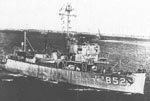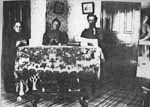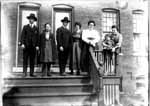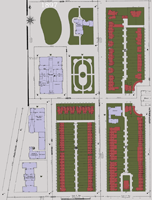The story of Pullman-built Patrol Craft Escort (Rescue) [PCE(R)] vessels 851, 852, and 853 (1943-1944)
The original text of this web page was published privately by CDR. F. S. Bayley, Jr. USNR
In 1952, under the direction of then governor Adlai E. Stevenson,
the state of Illinois set about documenting its contributions and efforts made during
World War II. The report is entitled,
Illinois
in the Second World War, and its primary author is Mary Watters. Volume II of
that work concerns the production front. According to it, the "Largest
manufacturer was the Pullman Standard Car Company, which became the outstanding producer
in the United States for the large type patrol boat (submarine chaser). These boats were
assembled in 14 sections in its Calumet yard without the laying of a keel. On the
George
M. Pullman, escort vessel, servicemen could travel 'Pullman' to the Pacific
battlegrounds. " (p. 91)
Click
here to learn more about PCEs and PCE(R)s from NavSource.
PCE(R) 851
| Harriet
Lowden Madlener and Florence Lowden Miller were with the commissioning party of Navy
patrol craft number 851 on February 22, 1944. George Willis, the last principal of the
Pullman Free School for Manual Training, is at the far right on the stairway. |

Photo courtesy of George R. Caruso
|
The
U.S.S. Rockville was laid down as
PCER--851,
patrol craft escort rescue, on 18 October 1943 by the Pullman Standard Car Co.,
Chicago, Ill.: launched 22 February 1944; and commissioned on 15 May 1944, Lt. Comdr.
Frank S. Bayley in command.
Following shakedown,
PCER--851 , built as a medical
rescue ship complete with a surgery, X-ray equipment, 65 hospital beds and an 11-man
medical staff, reported for duty in TG 26.1, at Bermuda, on 10 July 1944. Into August, she
patrolled in the Bermuda area ; escorted submarines between Norfolk and the British West
Indies ; and carried prisoners from
U--505, captured by a hunter-killer task
group built around
Guadalcanal (CVE--60) (q.v.), from Bermuda to Newport News.
On 20 August,
PCER--851 got underway for the
Pacific. She reported to ComServPac at Pearl Harbor on 15 September; took on more medical
equipment ; embarked additional medical personnel
; and sailed
west on the 21st.
In October she arrived at Milne Bay, Papua, and pushed on to
Manus, whence, on the 11th, she sailed for Leyte Gulf in TU 79.11.3.
En route, she screened the transports. On the 20th, she stood
off the Dulag beaches to receive casualties. After the landings she remained in the Dulag
area until the 25th, when, as Japanese air raids increased, she was ordered to Tacloban to
join TG 78.2. In the afternoon, shrapnel hit and exploded a 20mm. magazine. Four men were
injured.
Through November, the PCER continued her "casualty
care" mission in the Leyte Gulf area. In December, she accompanied forces to Ormoc
Bay
; then joined TG 78.3 to act as rescue and evacuation ship
for the Mindoro invasion. Holed at the waterline en route, she splashed one Japanese
plane; gave assistance in fighting fires; and rescued survivors of sunken ships. Arriving
at the target on the 15th, she got underway the same day to return to Leyte, whence she
continued on to New Guinea. Remaining in the New Guinea-Admiralty Islands area into
February, she headed for Saipan on the 3d and arrived on the 11th to stage for the Iwo
Jima campaign.
PCER--851 departed for the Volcano Islands on the
15th. Again she performed screening duties en route, and, after arrival, patrolled off the
beaches. She remained off Iwo Jima until 1 March, then headed back to Leyte.
On the 27th she departed Leyte for the Ryukyus as a unit of
the Southern Attack Force, On 1 April she arrived off Okinawa and at 0610 was
"greeted" by a single-engine Japanese plane which attempted to crash the
"851", but overshot its target and crashed into the sea some 25 yards astern of
the ship.
Through the 5th she patrolled, seeing little action. Then, on
the 6th, she began rescuing survivors and taking casualties from ships and landing craft
crashed by suicide boats and planes. The crews of
LCS--82, Maryland, Laffey, Morrison,
and
Ingraham were among those aided by the PCER.
On 28 June,
PCER--851 departed the Ryukyus. Six days
later she put into Saipan, whence she escorted
Rockwall to Pearl Harbor. Arriving
on the 19th, she was undergoing repairs when hostilities ceased in mid-August.
In mid-October the PCER got underway for the east coast. She
arrived at Norfolk in late November. In January 1946 she moved north to New London ;
conducted operations for the Underwater Sound Laboratory into March ; then continued on to
Boston.
Arriving on the 19th, she was decommissioned and placed in
service as a Naval Reserve training ship on 12 April. From then into 1950 she trained
reservists of the 1st Naval District. Placed in commission, in reserve in June 1950, she
returned to the active list on 22 November 1950, and through that year and most of the
next continued to operate primarily in the New England area.
On 15 October 1951,
PCER--851 was redesignated
EPCER--
851, experimental patrol craft escort rescue, and 4 days later she departed Boston
for Norfolk. Thence, she proceeded to her new homeport, Washington, D.C., and duty with
the Naval Research Laboratory.
Fitted with an electronics laboratory and workshop,
EPCER--851,
named
Rockville on 15 February 1956, conducted research operations out of
Washington, from Newfoundland to and including the Caribbean, until January 1965. Then
homeported at Norfolk, she continued her research operations, in conjunction with
representatives of the Western Electric Co., until 1968, when she was ordered inactivated.
Rockville was decommissioned and struck from the Navy list on 21 December 1968.
PCER--851 earned three battle stars during World War
II.
Click here
to read "A Risky Rescue", the story of the mission of the PCE(R) 851.
PCE(R) 852
| Laid down,
28 October 1943 by the Pullman Standard Car Manufacturing Co., Chicago, IL; Launched, 1
March 1944; Commissioned USS PCER-852, 26 May 1944; Decommissioned, (date unknown);
Renamed USS Battleboro (PCER-852), 15 February 1956; Reclassified an Experimental
Patrol Craft (Rescue) EPCER-852, (date unknown); Struck from the Naval
Register, (date unknown); Transferred to South Vietnam, 11 July 1966 and renamed Ngoc
Hoi (HQ-12); Escaped to the Philippines after the fall of South Vietnam; Renamed Miguel
Malvar (PS 19). |

U.S.S. Brattleboro

As the Ngoc Hoi (HQ-12)

As the Miguel Malvar (PS 19)
|
| An
invitation to the commission ceremonies, May, 1944 for PCE(R) 852. |
|
Click here to
read "Over a Century and a Half and Still Sailing" by Martin J. Hacula, the
story of PCE(R) 852.
PCE(R) 853
| Laid down,
16 November 1943 at Pullman Standard Car Manufacturing Co., Chicago, Ill; Launched, 18
March 1944; Commissioned USS PCE(R)-853, at New Orleans, LA, 15 June 1944;
Decommissioned at Green Cove, Fla. October 1945; Laid up in the Atlantic Reserve Fleet;
Recommissioned, 28 November 1950; Renamed USS Amherst (PCER-853), 15 February 1956;
Decommissioned, 6 February 1970; Struck from the Naval Register, 3 June 1970; Transferred
to South Vietnam, June 1970 and renamed Van Kiep II (HQ-14); Escaped to the
Philippines after fall of South Vietnam and renamed Datu Marikudo (PS 23). |

|
Click here to
read "Patrol Craft- Escort and Rescue" by Guy B. Merritt, the story of PCE(R)
853.










